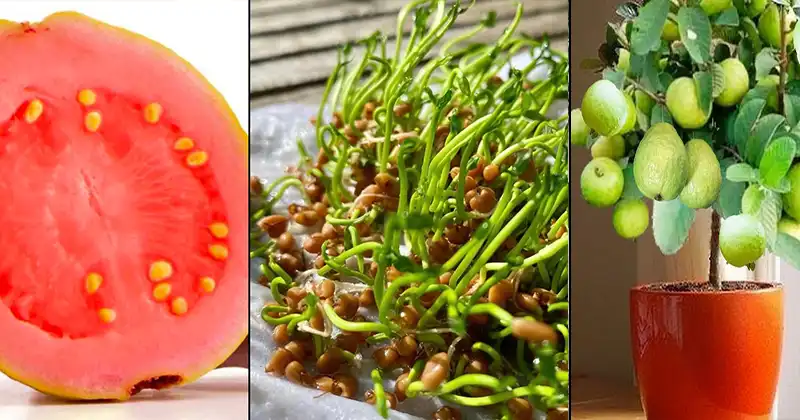Guava (Psidium guajava) is a tropical fruit that delights with its sweet, aromatic flavor and is packed with essential nutrients. While guava trees typically thrive in tropical and subtropical regions, it’s entirely possible to grow this delicious fruit at home in pots, allowing individuals in various climates to enjoy their own guava harvest. In this detailed guide, we’ll walk you through the entire process of growing guava at home in pots, from harvesting seeds to caring for your potted guava tree.
Harvesting Guava Seeds
To start your journey to homegrown guavas, you’ll need guava seeds. Follow these steps to harvest seeds from a ripe guava fruit:
Materials You’ll Need:
- Ripe guava fruit
- Knife
- Spoon
Step 1: Choose a Ripe Guava
Select a mature, ripe guava. Ensure it’s fully ripe for the best seed quality. You’ll know it’s ripe when it yields slightly to gentle pressure.
Step 2: Cut Open the Guava
Slice the guava in half using a clean, sharp knife. Be cautious when cutting to avoid damaging the seeds.
Step 3: Remove Seeds
Gently scoop out the seeds from the center of the guava using a spoon. You may also find seeds embedded in the flesh; collect all of them.
Step 4: Clean the Seeds
Rinse the collected seeds under running water to remove any remaining fruit flesh. Pat them dry with a clean paper towel.
Germinating Guava Seeds
Once you’ve harvested the seeds, it’s time to prepare them for planting. Germination is a crucial step to ensure your guava plants get off to a healthy start.
Materials You’ll Need:
- Guava seeds
- Moist paper towel
- Plastic ziplock bag
Step 1: Prepare the Paper Towel
Place the guava seeds on a moist paper towel. The paper towel should be damp but not soaking wet. Ensure that the seeds are spaced apart from each other.
Step 2: Fold the Paper Towel
Fold the paper towel over the seeds to cover them gently. This creates a seed packet.
Step 3: Seal in a Ziplock Bag
Place the folded paper towel with seeds inside a plastic ziplock bag. Seal the bag to create a moist and controlled environment for germination.
Step 4: Store in a Warm Place
Put the sealed ziplock bag in a warm and bright location, such as on a windowsill or near a heat source. Guava seeds typically germinate best in temperatures between 75°F to 85°F (24°C to 29°C).
Step 5: Monitor and Wait
Check the seeds regularly to ensure the paper towel remains moist. Germination can take anywhere from 2 to 8 weeks, so be patient.
Planting Your Guava Seedlings in Pots
Once your guava seeds have sprouted and developed a small root, they are ready to be transplanted into pots.
Materials You’ll Need:
- Guava seedlings
- Potting mix
- Pots with drainage holes
- Watering can
- Fertilizer (balanced, slow-release)
Step 1: Prepare the Pots
Choose pots that are at least 10-12 inches in diameter with good drainage holes to prevent waterlogging. Fill them with a well-draining potting mix suitable for fruit trees.
Step 2: Transplant Seedlings
Create a small hole in the center of the potting mix and carefully place the germinated guava seedling with the root down into the hole. Gently cover the seedling with soil.
Step 3: Watering
Water the newly transplanted seedlings thoroughly and consistently. Keep the soil consistently moist but not waterlogged. Guava trees prefer a slightly humid environment.
Step 4: Fertilization
Once your guava seedlings are established, begin fertilizing with a balanced, slow-release fertilizer to provide essential nutrients.
Caring for Your Guava Potted Tree
To ensure the success of your potted guava tree, it’s important to provide proper care and attention:
1. Sunlight: Guava trees thrive in full sun, so place your pots in a location that receives at least 6-8 hours of direct sunlight per day.
2. Watering: Water your guava tree consistently to maintain even moisture. Guavas prefer well-draining soil, so avoid waterlogged conditions.
3. Pruning: Regularly prune your guava tree to maintain its shape, remove dead or diseased branches, and encourage new growth.
4. Pests and Diseases: Keep an eye out for common guava pests like fruit flies and aphids. Apply appropriate treatments if necessary.
5. Frost Protection: If you live in a cooler climate, provide frost protection for your guava during winter months. Move the pots indoors or use frost cloth to protect the tree from freezing temperatures.
6. Fruit Thinning: Thin out excess fruit when it’s still small to ensure that the remaining fruits grow larger and healthier.
7. Harvesting: Guavas are typically ready to harvest when they give slightly to gentle pressure. Simply twist the fruit gently to detach it from the tree.
Growing guava at home in pots is a rewarding endeavor that can yield delicious fruits in a variety of climates. With the right care and attention, your potted guava tree can thrive and provide you with a bountiful harvest for years to come. Enjoy the sweet, tropical flavors of your own homegrown guavas!
